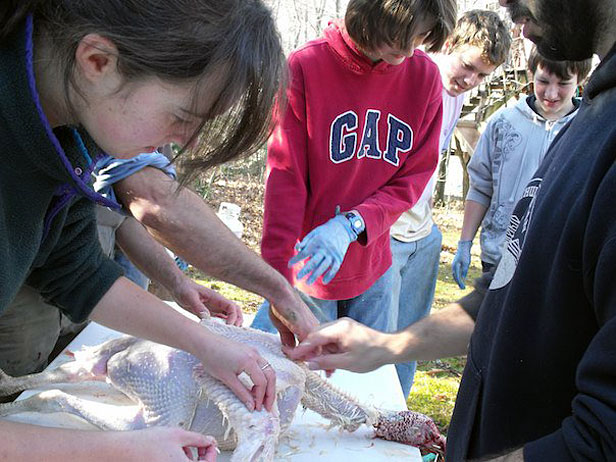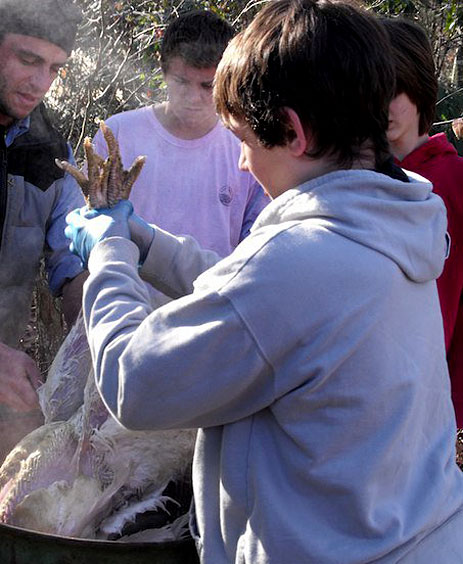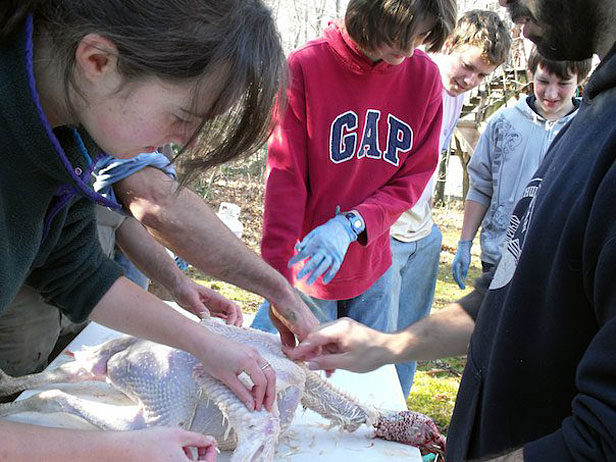 Photos: Tessa Aguar
Photos: Tessa Aguar
“She’s a killer,” I tell my eighth-grade student’s family.
“Yeah, it’s been a hard thing for us to deal with,” her uncle says. “Some of the family are vegetarians, while others of us are farmers … it’s been a real controversy.”
We’ve just finished eating turkeys at our annual Thanksgiving Celebration that his niece helped raise and slaughter during her time here as a student at the Arthur Morgan School, a boarding and day school for 7th to 9th graders in Western North Carolina. His niece is from Detroit, where slaughtering turkeys for Thanksgiving dinner is unheard of, yet she leapt at the opportunity to do so when given the chance.
I’m not surprised there was controversy in her family about it, as there has been controversy in our community over killing animals for some time.
Earth Quakers
Arthur Morgan School has existed since 1962, as a peace-loving, consensus decision-making, community-minded home away from home for teenagers looking for an alternative to the traditional school system. For most of its history, it was a vegetarian school, believing in the principles of Francis Moore Lappé’s Diet for a Small Planet. Staff and students are committed to living a life as sustainably as possible, chopping our own wood to make heat, cooking our food straight from the garden for sustenance, and choosing to entertain one another with song and games rather than televisions.
Each year, students and staff invite their families and friends to join us in celebrating Thanksgiving, most recently to the tune of 180 people. Thanksgiving celebrations always include Toficken (a play on Tofurkey), but also turkeys to please the meat eaters in the crowd. In the past, the kitchen coordinator worked hard to find affordable, humanely raised turkeys, often from the local Whole Foods, identified as “naturally raised” or “Hormone-free,” traveling from the state of Pennsylvania down to the mountains of North Carolina.
In 2004, however, the gardener started to think of a new plan. Having raised chickens before, Tal Galton thought it only seemed logical for the school community to embark on raising its own turkeys for the annual celebration.
“I was really interested in raising as much of our own food as possible, especially any meat that we were going to eat. I felt strongly about getting meat from places where you know how animals are treated, what they’re eating,” he said. “If we were going to eat meat once a year — especially if it’s special — why not do it ourselves? Might as well turn it into an educational experience.”
With a one-acre garden, we were already raising our own vegetables with a few laying hens for eggs. At our weekly all-school meeting, Tal brought a proposal to raise our own turkeys rather than buy them from the store. Everyone seemed to see the logic behind Tal’s proposal and after only two meetings, decided to move forward.
After attending a workshop on raising heritage turkeys at our local Organic Grower’s School, Tal was inspired to order some birds from Murray McMurray’s and get started. The minimum order was 15, more than we needed for our annual feast, but we lost a few in the travel due to turkeys’ sensitivity to their environment and a couple more from a wily predator in late May. By November, though, the turkeys were fat and ready.
When asked who would like to participate in the turkey slaughter, about three-fourths of the student body volunteered, and about half the staff, or about 20 people total.
To keep things manageable and safe, only six to eight people at a time work on the turkeys, killing the biggest ones first and giving the smaller ones a few more days. Everyone gathered to talk first about safety, learning how sharp the knives were, how hot the scalding water had to be to take off the feathers, and lastly about how to make sure the turkeys were carried safely, so as not to harm them or each other.
Killing the turkeys is an emotional experience. “For the first few years I found that I would get cranky afterwards,” Tal says. “I started to make this association between killing the animals and my emotional state. Violence leads to more violence.”
So he does his best to prepare the group for how they might feel, and the session is started with a moment of silence — a Quaker tradition the school employs throughout the day as a chance for people to take a moment and reflect. In this case, it allows the group to get centered and focus on respecting the animals and each other, while considering the implications of taking one life to feed another.
 The process begins with hanging the turkey upside down and slitting its throat with an extremely sharp knife. Scalding the feathers in hot water and plucking the turkey comes next, the little feathers in bundles, while the coveted wing feathers are hardest to pull. The head and legs are chopped off and then the cleaned bird goes to the eviscerating station.
The process begins with hanging the turkey upside down and slitting its throat with an extremely sharp knife. Scalding the feathers in hot water and plucking the turkey comes next, the little feathers in bundles, while the coveted wing feathers are hardest to pull. The head and legs are chopped off and then the cleaned bird goes to the eviscerating station.
Here, the fat gland is shaved and the neck cavity is cut so that pulling the organs out the other end is a little smoother. Special pains are taken to cut the bottom end of the bird so that the colon isn’t sliced into, and then with a concentrated tug, the organs are pulled from the hot cavity in a glistening mass. The first time seeing this, everyone is in awe. The intestines are connected with a thin, web-like membrane, at the end of which is the incredible gizzard.
Tal slices into it to expose the multi-colored, shiny pebbles inside and everyone gasps with amazement. So foreign to our own digestive systems, we ogle at the rocks and relish in our new discoveries. After all of this, the turkeys are cleaned one last time, wrapped, and weighed, ready for cooking.
Turkey: The gateway meat
Our first school-raised turkeys were a success. Students gloated to their families that they had killed the very turkeys their parents were eating, and most everyone commented that the turkeys tasted better that year.
Soon, however, that success inspired a student to suggest that we eat meat more often, perhaps raise some more animals, or simply prepare meat for our family style lunches, or at the boarding houses where boarding families eat breakfasts and dinners together.
It was a challenging proposal for the community, especially for those who came to the Arthur Morgan School because of its Gandhian nonviolent beliefs or who relied on the comfort of living in a community where eating meat was a non-issue.
On the other hand, those who had moved here as meat-eaters said they were finding it hard to get enough protein in the carb-heavy meals the school provided. They felt their personal health was at stake and saw this as an opportunity to make nutritional changes that would improve their lives.
Others of us thought it most important that whether we ate meat or not was less important than focusing on buying sustainably raised, local foods.
What had been a fluid and easy decision in regards to raising turkeys became an ethical debate about our overall food philosophy.
Lots and lots of meatings
Elliot Smith, the student who raised the idea of eating meat more often, put together a massive proposal with information about the costs, safety concerns, and potential sources of local meat for the staff to look over. He had students and staff who agreed with his idea sign a petition, creating a stir in the community. Folks who wanted to eat mea
t saw him as a hero. Others found the petition disturbing and were frustrated at the politicking. The staff organized a “fishbowl” discussion for people on both sides.
The school was abuzz with the idea of changing tradition. We began to infuse our academic program with curriculum on the food system, creating a “Food System Debate,” where students took up sides for organic, local, or conventional food production. Students in my house who were once vegetarian changed into “free-range-etarians” or decided to only eat organic foods. Many of my students actually became vegetarians or vegans after learning more about where their food comes from.
Staff meeting took up the discussion away from students, and emotions became more volatile. Some staff cried. Others pounded the floor or raised their voices with frustration. Our consensus practices were challenged, as one staff member decided to “block consensus,” while others said blocking consensus could not be done.
We called in practiced Quakers to consult with on our practices and held special meetings to thresh out our food philosophy. Sometimes we just put the whole thing to rest for a while so that we could take a deep breath and think.
It took us over a year of meetings and thoughtful consideration to come to a compromise. Finally, it was decided that house parents would have autonomy in their boarding houses to eat meat if they so chose, while the school would remain vegetarian.
As time has gone by, Tal has expanded our livestock and vegetable production a little each year, adding goats for milk, sheep for wool, and working hard over the summer to put up as many vegetables as possible so we could eat them during the school year. Some of the boarding houses decided to raise and slaughter a few chickens for meat, while we have considered as a whole school whether we want to begin raising goats or sheep for meat animals. The discussions have become less emotional, but just as ethics-affirming as they always have been for our community.
There are awesome resources out there for students of all ages to read and see what it means to eat a fast-food hamburger or to buy a conventionally farmed potato, but standardized tests don’t ask students what methods they could use to improve their soil on an organic farm, or what the most humane way to raise a turkey is, or how to define sustainability. For our students, who are in the most impressionable period of their lives, they’re able to make critical, ethical decisions about what kind of food they want to eat as an adult due to the amazing freedom we have to raise our own animals on our school farm.
So it was no surprise this year when we held an all-school meeting to see which students wanted to participate in the turkey killing and nearly every student raised their hand. One of our ninth grade students said, “You’ll never get this opportunity at another school,” encouraging other students to give it a go.
Who knew that raising our own turkeys would become such an incredible education on so many levels?
Although the controversy isn’t what it was at one time, the issue of raising and killing animals will continue to be a rich experiential tool for us to teach our children about ethics, economics, health, and the environment. This topic will never lack for controversy, but we feel it’s worthwhile controversy if it helps our children make conscious decisions about the food they eat.



